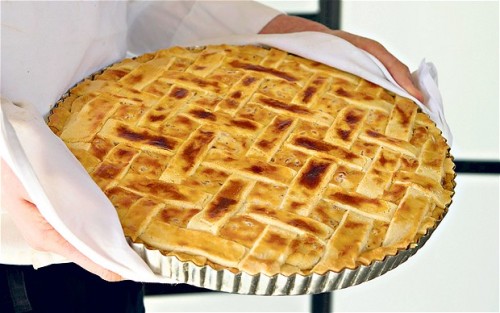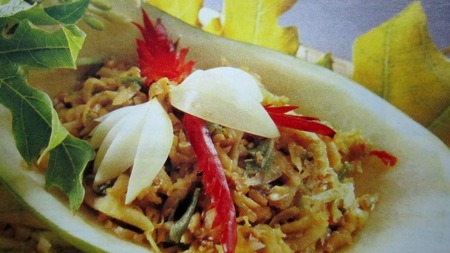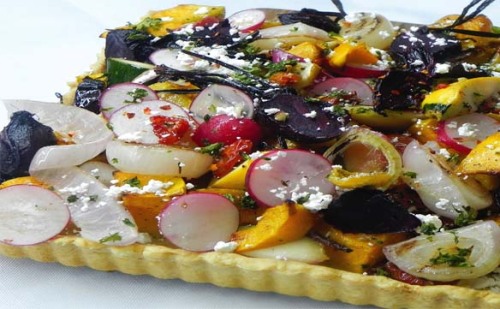Pattaya Style Chilli Fried Beef Recipe
Ingredients
500g - beef tenderloin, finely sliced
3 Tbsp - Peanut Oil
3 Tbsp - Fish sauce
2 Tbsp - Oyster sauce
1 Tbsp - Sugar
1 tsp - corn flour (cornstarch) mixed with 1 Tbsp water.
1 - Onion; peeled and sliced in rounds
¼ - green capsicum (bell pepper); diced
¼ - red capsicum (bell pepper); diced
10 - dried shiitake mushroom; soaked in water and finely sliced
140g - canned sour bamboo shoots; sliced
a handful of basil leaves
Spice Paste
6 - red chillies
10 - bird's eye chillies
3 - cloves garlic; peeled
Method
Combine all spice paste ingredients in a blender, well mixed and blend until smooth.
Heat 1 tbsp oil and fry spice paste until fragrant.
Add mushrooms and stir fry until soft.
Add in beef, oyster sauce, sugar and fish sauce. Stir-fry for another 3 to 5 minutes.
Add onion, capsicums, bamboo shoots and basil leaves. Pour in corn flour mixture and stir for a few minutes.
Garnish with spring onion and serve immediately with rice.
Recent Posts
Categories
- Asian Recipes
- Atkin Diet
- Best Reading
- Biscuits
- Breakfast Recipes
- Cakes
- Chinese Recipes
- Cookies
- Cooking Tips
- Egg Recipes
- Etc
- Etiquette
- Fish Recipes
- Food Articles
- Food History
- Food Info
- Food Tips
- Halal Food
- Health
- Ice Cream
- Indian Recipes
- Japanese Recipes
- Kids Recipes
- Kitchen Tips
- Malaysian Recipes
- Middle East Recipes
- Oriental Recipes
- Promo
- Recipes
- Resepi
- Restaurant
- Soup
- Sweet Taste
- Thai Recipes
- Vegetarian
- Western Recipes
Home » Archives for April 2011
Recipe: Durian Moon Cake
Durian Moon Cake Recipe
Ingredients for pastry:
300g golden syrup
3/4 tbsp alkaline water
95g corn oil
400g plain flour - sifted
1/4 tsp thick soy sauce (for colour)
To make the pastry:
1. Combine golden syrup and alkaline water in a mixing bowl.
2. Add corn oil and mix with a wooden spoon.
3. Add thick soy sauce and stir well. Set aside for 4-5 hours.
4. Fold in sifted flour and mix evenly to form a smooth dough.
5. Set dough aside again for another 4-5 hours
Ingredients for durian filling:
300g durian flesh - blend into puree
500g lotus seeds - boil in 1,200ml water until soft and blend into a paste
4 tbsp castor sugar
500g castor sugar* 2 tbsp maltose
To make the filling:
1. Put 4 tbsp sugar in a heavy-based wok, and cook till you get golden brown caramel.
2. Add lotus seed paste gradually and cook till smooth. Add 500g sugar and stir till mixture thickens.
3. Add oil gradually and mix well. Add durian and maltose. Stir until mixture is smooth and does not stick to the centre of the wok.
4. Remove and cool, preferably overnight, before dividing the filling into 110g balls.
Footnote: If you like a filling with a nutty bite, add 50g toasted olive nuts after the filling has cooled completely.
To make egg glaze, mix well and strain:
1 egg yolk
1 whole egg
1 tbsp water
Pinch of salt
To make the moon cake:
1. Divide pastry dough into 45g balls. Flatten dough and wrap durian filling.
2. Dust wooden mould lightly with flour, tapping out any excess.
3. Put dough-wrapped filling into mould. Knock out and place moon cakes on slightly greased tray.
4. Bake in preheated oven at 180°C for 13 minutes. Remove and leave to cool for 1 minute.
5. Brush with egg glaze and bake for another 5 minutes or till done
Ingredients for pastry:
300g golden syrup
3/4 tbsp alkaline water
95g corn oil
400g plain flour - sifted
1/4 tsp thick soy sauce (for colour)
To make the pastry:
1. Combine golden syrup and alkaline water in a mixing bowl.
2. Add corn oil and mix with a wooden spoon.
3. Add thick soy sauce and stir well. Set aside for 4-5 hours.
4. Fold in sifted flour and mix evenly to form a smooth dough.
5. Set dough aside again for another 4-5 hours
Ingredients for durian filling:
300g durian flesh - blend into puree
500g lotus seeds - boil in 1,200ml water until soft and blend into a paste
4 tbsp castor sugar
500g castor sugar* 2 tbsp maltose
To make the filling:
1. Put 4 tbsp sugar in a heavy-based wok, and cook till you get golden brown caramel.
2. Add lotus seed paste gradually and cook till smooth. Add 500g sugar and stir till mixture thickens.
3. Add oil gradually and mix well. Add durian and maltose. Stir until mixture is smooth and does not stick to the centre of the wok.
4. Remove and cool, preferably overnight, before dividing the filling into 110g balls.
Footnote: If you like a filling with a nutty bite, add 50g toasted olive nuts after the filling has cooled completely.
To make egg glaze, mix well and strain:
1 egg yolk
1 whole egg
1 tbsp water
Pinch of salt
To make the moon cake:
1. Divide pastry dough into 45g balls. Flatten dough and wrap durian filling.
2. Dust wooden mould lightly with flour, tapping out any excess.
3. Put dough-wrapped filling into mould. Knock out and place moon cakes on slightly greased tray.
4. Bake in preheated oven at 180°C for 13 minutes. Remove and leave to cool for 1 minute.
5. Brush with egg glaze and bake for another 5 minutes or till done
Resepi Sotong Salut Rangup
Resepi Sotong Salut Rangup
Bahan-bahan:
300 gm sotong - bersihkan
2 cawan tepung naik sendiri
2 cawan tepung gandum
1 biji telur
1 sudu besar ketumbar - ditumbuk
1 sudu kecil jintan manis - ditumbuk
1 sudu kecil jintan putih - ditumbuk
1 sudu kecil lada hitam - ditumbuk
Garam secukup rasa
Air secukupnya
Minyak untuk menggoreng
Cara Menyediakan:
1. Gaul kedua jenis tepung, campurkan dengan bahan tumbuk dan garam. Bahagikan kepada dua bahagian.
2. Satu bahagian dicampur telur serta air dan diadun sehingga menjadi bater untuk menggoreng pisang.
3. Panaskan minyak, celup sotong dalam bater dan golekkan ke dalam satu lagi bahagian tepung. Goreng hingga kuning.
4. Hidang dengan sos cili.
Bahan-bahan:
300 gm sotong - bersihkan
2 cawan tepung naik sendiri
2 cawan tepung gandum
1 biji telur
1 sudu besar ketumbar - ditumbuk
1 sudu kecil jintan manis - ditumbuk
1 sudu kecil jintan putih - ditumbuk
1 sudu kecil lada hitam - ditumbuk
Garam secukup rasa
Air secukupnya
Minyak untuk menggoreng
Cara Menyediakan:
1. Gaul kedua jenis tepung, campurkan dengan bahan tumbuk dan garam. Bahagikan kepada dua bahagian.
2. Satu bahagian dicampur telur serta air dan diadun sehingga menjadi bater untuk menggoreng pisang.
3. Panaskan minyak, celup sotong dalam bater dan golekkan ke dalam satu lagi bahagian tepung. Goreng hingga kuning.
4. Hidang dengan sos cili.
The Red Bananas
Red bananas are of high nutritional value and usually contain a high levels of potassium, beta carotene and Vitamin C. 1 Medium sized banana contains the following:
110 Calories
0g Fat
0g Cholesterol
0g Sodium
29g Carbohydrates
400mg Potassium
1g Protein
21g Sugar
4g Dietary Fibre
15% Vitamin C
2% Iron
These red bananas grow all over Asia and South America. The red banana tree can grow up to 8 to 25 feet depending on the plant variety. Fruits ripen during springtime.For red bananas planting to harvest is usually around about 18 months and grows in subtropical areas. Planting your own red bananas is always a great idea as they are known to be quite expensive all over. Make sure your soil is well-drained, slightly acidic and moist at all times. These red banana plants grow well in direct sunlight but you will need to protect it from the wind to avoid the leaves getting torn.
110 Calories
0g Fat
0g Cholesterol
0g Sodium
29g Carbohydrates
400mg Potassium
1g Protein
21g Sugar
4g Dietary Fibre
15% Vitamin C
2% Iron
These red bananas grow all over Asia and South America. The red banana tree can grow up to 8 to 25 feet depending on the plant variety. Fruits ripen during springtime.For red bananas planting to harvest is usually around about 18 months and grows in subtropical areas. Planting your own red bananas is always a great idea as they are known to be quite expensive all over. Make sure your soil is well-drained, slightly acidic and moist at all times. These red banana plants grow well in direct sunlight but you will need to protect it from the wind to avoid the leaves getting torn.
Pastiera Neopolitana recipe
Pastiera Neopolitana recipe
Ingredients
For the pastry
12oz/350g plain flour
8oz/225g unsalted butter
3½ox/100g icing sugar
3 egg yolks
For the filling
10oz/300g farro
2 pints/1 litre full fat milk
1 vanilla pod
1 cinnamon stick
A few pieces of lemon zest
7oz/200g caster sugar
3 whole eggs
5oz/150g candied fruit
7oz/200g ricotta
1½ fl oz/50ml orange flower water
In a blender pulse chop the flour, butter and icing sugar until it resembles breadcrumbs. Add the egg yolks and pulse a little more, turn out the pastry, and then knead very briefly to bring it together.
Wrap in cling film and chill for a couple of hours. Soak the farro in water for a few hours.
Boil the farro in the milk with the vanilla, cinnamon and lemon zest and half the sugar. It will take about 40 minutes to go soft (depending on how long it was soaked for). You may need to add more milk if it reduces too much. When soft, drain off excess liquid and set aside to cool.
Preheat the oven to 320F/160C/Gas 3. Roll out two thirds of the pastry and push it into the tart shell. Spike the base a few times with a fork and put in the freezer for 10 minutes. Bake until light brown.
Using an electric whisk, whisk the eggs with the remaining sugar fast for five minutes. Stir in the ricotta, candied peel and orange flower water. Add the farro and stir to combine. Pour into the baked tart shell.
Roll out the remainder of the pastry, cut it into strips and then lay on top in a lattice shape. Bake for a further 45 minutes, until light brown and firm to the touch.
By Stevie Parle
Ingredients
For the pastry
12oz/350g plain flour
8oz/225g unsalted butter
3½ox/100g icing sugar
3 egg yolks
For the filling
10oz/300g farro
2 pints/1 litre full fat milk
1 vanilla pod
1 cinnamon stick
A few pieces of lemon zest
7oz/200g caster sugar
3 whole eggs
5oz/150g candied fruit
7oz/200g ricotta
1½ fl oz/50ml orange flower water
In a blender pulse chop the flour, butter and icing sugar until it resembles breadcrumbs. Add the egg yolks and pulse a little more, turn out the pastry, and then knead very briefly to bring it together.
Wrap in cling film and chill for a couple of hours. Soak the farro in water for a few hours.
Boil the farro in the milk with the vanilla, cinnamon and lemon zest and half the sugar. It will take about 40 minutes to go soft (depending on how long it was soaked for). You may need to add more milk if it reduces too much. When soft, drain off excess liquid and set aside to cool.
Preheat the oven to 320F/160C/Gas 3. Roll out two thirds of the pastry and push it into the tart shell. Spike the base a few times with a fork and put in the freezer for 10 minutes. Bake until light brown.
Using an electric whisk, whisk the eggs with the remaining sugar fast for five minutes. Stir in the ricotta, candied peel and orange flower water. Add the farro and stir to combine. Pour into the baked tart shell.
Roll out the remainder of the pastry, cut it into strips and then lay on top in a lattice shape. Bake for a further 45 minutes, until light brown and firm to the touch.
By Stevie Parle
Resepi Kerabu Betik
Resepi Kerabu Betik
Bahan-bahan:
200 gm betik tua - disagat halus memanjang
2 biji limau nipis - diambil airnya
1/2 sudu kecil serbuk perasa
Bahan ditumbuk halus:
50 gm cili padi
30 gm gula
30 gm gula merah
100 gm bawang merah
100 gm udang kering
Cara menyediakan:
1. Gaulkan bahan tumbuk dengan betik yang disagat.
2. Campurkan air limau dan serbuk perasa. Hias dan hidangkan
(Anda juga boleh mencampurkan kacang tanah atau biji gajus yang telah digorengdan ditumbuk halus jika suka)
Sumber: Saji
Bahan-bahan:
200 gm betik tua - disagat halus memanjang
2 biji limau nipis - diambil airnya
1/2 sudu kecil serbuk perasa
Bahan ditumbuk halus:
50 gm cili padi
30 gm gula
30 gm gula merah
100 gm bawang merah
100 gm udang kering
Cara menyediakan:
1. Gaulkan bahan tumbuk dengan betik yang disagat.
2. Campurkan air limau dan serbuk perasa. Hias dan hidangkan
(Anda juga boleh mencampurkan kacang tanah atau biji gajus yang telah digorengdan ditumbuk halus jika suka)
Sumber: Saji
The Problem with Traditional Vegetable Gardening?
Traditional vegetable gardens require an enormous amount of hard work and attention - weeding, feeding and strict planting schedules. There is also the problem of seasonality, allowing beds to rest during the cooler months producing nothing at all. Then we are told to plant green manure crops, add inorganic fertilizers and chemicals to adjust imbalanced soils. It takes a lot of time, dedication and a year-round commitment to grow your own food the traditional way.
But does it really need to be that difficult?
Let me ask you this question. Does a forest need to think how to grow? Does its soil need to be turned every season? Does someone come along every so often and plant seeds or take pH tests? Does it get weeded or sprayed with toxic chemicals?
Of course not!
Traditional vegetable gardening techniques are focused on problems. Have you noticed that gardening books are full of ways to fix problems? I was a traditional gardener for many years and I found that the solution to most problems simply caused a new set of problems. In other words, the problem with problems is that problems create more problems.
Let’s take a look at a common traditional gardening practice and I will show you how a single problem can escalate into a whole host of problems.
Imagine a traditional vegetable garden, planted with rows of various vegetables. There are fairly large bare patches between the vegetables. To a traditional gardener, a bare patch is just a bare patch. But to an ecologist, a bare patch is an empty niche space. An empty niche space is simply an invitation for new life forms to take up residency. Nature does not tolerate empty niche spaces and the most successful niche space fillers are weeds. That’s what a weed is in ecological terms - a niche space filler. Weeds are very good colonizing plants. If they weren’t, they wouldn’t be called weeds.
Now back to our story. Weeds will grow in the empty niche spaces. Quite often there are too many weeds to pick out individually, so the traditional gardener uses a hoe to turn them into the soil. I have read in many gardening books, even organic gardening books, that your hoe is your best friend. So the message we are getting is that using a hoe is the solution to a problem.
However, I would like to show you how using a hoe actually creates a new set of problems. Firstly, turning soil excites weed seeds, creating a new explosion of weeds. And secondly, turning soil upsets the soil ecology. The top layer of soil is generally dry and structureless. By turning it, you are placing deeper structured soil on the surface and putting the structureless soil underneath. Over time, the band of structureless soil widens. Structureless soil has far less moisture holding capacity, so the garden now needs more water to keep the plants alive.
In addition to this problem, structureless soil cannot pass its nutrients onto the plants as effectively. The garden now also needs the addition of fertilisers. Many fertilisers kill the soil biology which is very important in building soil structure and plant nutrient availability. The soil will eventually turn into a dead substance that doesn’t have the correct balance of nutrients to grow fully developed foods. The foods will actually lack vitamins and minerals. This problem has already occurred in modern-day agriculture. Dr Tim Lobstein, Director of the Food Commission said. "… today's agriculture does not allow the soil to enrich itself, but depends on chemical fertilisers that don't replace the wide variety of nutrients plants and humans need." Over the past 60 years commercially grown foods have experienced a significant reduction in nutrient and mineral content.
Can you see how we started with the problem of weeds, but ended up with the new problems of lower water-holding capacity and infertile soils. And eventually, we have the potentially serious problem of growing food with low nutrient content. Traditional gardening techniques only ever strive to fix the symptom and not the cause.
However, there is a solution! We must use a technique that combines pest ecology, plant ecology, soil ecology and crop management into a method that addresses the causes of these problems. This technique must be efficient enough to be economically viable. It also needs to be able to produce enough food, per given area, to compete against traditional techniques.
I have been testing an ecologically-based method of growing food for several years. This method uses zero tillage, zero chemicals, has minimal weeds and requires a fraction of the physical attention (when compared to traditional vegetable gardening). It also produces several times more, per given area, and provides food every single day of the year.
My ecologically-based garden mimics nature in such a way that the garden looks and acts like a natural ecosystem. Succession layering of plants (just as we see in natural ecosystems) offers natural pest management. It also naturally eliminates the need for crop rotation, resting beds or green manure crops. Soil management is addressed in a natural way, and the result is that the soil’s structure and fertility get richer and richer, year after year. Another benefit of this method is automatic regeneration through self-seeding. This occurs naturally as dormant seeds germinate; filling empty niche spaces with desirable plants, and not weeds.
Unfortunately, the biggest challenge this method faces is convincing traditional gardeners of its benefits. Like many industries, the gardening industry gets stuck in doing things a certain way. The ecologically-based method requires such little human intervention that, in my opinion, many people will get frustrated with the lack of needing to control what’s happening. Naturally people love to take control of their lives, but with this method you are allowing nature to take the reins. It’s a test of faith in very simple natural laws. However, in my experience these natural laws are 100% reliable.
Another reason that traditional gardeners may not like this method is that it takes away all the mysticism of being an expert. You see, this method is so simple that any person, anywhere in the world, under any conditions, can do it. And for a veteran gardener it can actually be quite threatening when an embarrassingly simple solution comes along.
I have no doubt that this is the way we will be growing food in the future. It’s just commonsense. Why wouldn’t we use a method that produces many times more food with a fraction of the effort? I know it will take a little while to convince people that growing food is actually very instinctual and straightforward, but with persistence and proper explanation, people will embrace this method.
Why? Because sanity always prevails…
…eventually!
By Jonathan White, environmental scientist.
Jonathan White is an Environmental Scientist and the founder of the Food4Wealth Method. For more information see www.Food4Wealth.com
Secret Restaurant Recipes: Click Here!
But does it really need to be that difficult?
Let me ask you this question. Does a forest need to think how to grow? Does its soil need to be turned every season? Does someone come along every so often and plant seeds or take pH tests? Does it get weeded or sprayed with toxic chemicals?
Of course not!
Traditional vegetable gardening techniques are focused on problems. Have you noticed that gardening books are full of ways to fix problems? I was a traditional gardener for many years and I found that the solution to most problems simply caused a new set of problems. In other words, the problem with problems is that problems create more problems.
Let’s take a look at a common traditional gardening practice and I will show you how a single problem can escalate into a whole host of problems.
Imagine a traditional vegetable garden, planted with rows of various vegetables. There are fairly large bare patches between the vegetables. To a traditional gardener, a bare patch is just a bare patch. But to an ecologist, a bare patch is an empty niche space. An empty niche space is simply an invitation for new life forms to take up residency. Nature does not tolerate empty niche spaces and the most successful niche space fillers are weeds. That’s what a weed is in ecological terms - a niche space filler. Weeds are very good colonizing plants. If they weren’t, they wouldn’t be called weeds.
Now back to our story. Weeds will grow in the empty niche spaces. Quite often there are too many weeds to pick out individually, so the traditional gardener uses a hoe to turn them into the soil. I have read in many gardening books, even organic gardening books, that your hoe is your best friend. So the message we are getting is that using a hoe is the solution to a problem.
However, I would like to show you how using a hoe actually creates a new set of problems. Firstly, turning soil excites weed seeds, creating a new explosion of weeds. And secondly, turning soil upsets the soil ecology. The top layer of soil is generally dry and structureless. By turning it, you are placing deeper structured soil on the surface and putting the structureless soil underneath. Over time, the band of structureless soil widens. Structureless soil has far less moisture holding capacity, so the garden now needs more water to keep the plants alive.
In addition to this problem, structureless soil cannot pass its nutrients onto the plants as effectively. The garden now also needs the addition of fertilisers. Many fertilisers kill the soil biology which is very important in building soil structure and plant nutrient availability. The soil will eventually turn into a dead substance that doesn’t have the correct balance of nutrients to grow fully developed foods. The foods will actually lack vitamins and minerals. This problem has already occurred in modern-day agriculture. Dr Tim Lobstein, Director of the Food Commission said. "… today's agriculture does not allow the soil to enrich itself, but depends on chemical fertilisers that don't replace the wide variety of nutrients plants and humans need." Over the past 60 years commercially grown foods have experienced a significant reduction in nutrient and mineral content.
Can you see how we started with the problem of weeds, but ended up with the new problems of lower water-holding capacity and infertile soils. And eventually, we have the potentially serious problem of growing food with low nutrient content. Traditional gardening techniques only ever strive to fix the symptom and not the cause.
However, there is a solution! We must use a technique that combines pest ecology, plant ecology, soil ecology and crop management into a method that addresses the causes of these problems. This technique must be efficient enough to be economically viable. It also needs to be able to produce enough food, per given area, to compete against traditional techniques.
I have been testing an ecologically-based method of growing food for several years. This method uses zero tillage, zero chemicals, has minimal weeds and requires a fraction of the physical attention (when compared to traditional vegetable gardening). It also produces several times more, per given area, and provides food every single day of the year.
My ecologically-based garden mimics nature in such a way that the garden looks and acts like a natural ecosystem. Succession layering of plants (just as we see in natural ecosystems) offers natural pest management. It also naturally eliminates the need for crop rotation, resting beds or green manure crops. Soil management is addressed in a natural way, and the result is that the soil’s structure and fertility get richer and richer, year after year. Another benefit of this method is automatic regeneration through self-seeding. This occurs naturally as dormant seeds germinate; filling empty niche spaces with desirable plants, and not weeds.
Unfortunately, the biggest challenge this method faces is convincing traditional gardeners of its benefits. Like many industries, the gardening industry gets stuck in doing things a certain way. The ecologically-based method requires such little human intervention that, in my opinion, many people will get frustrated with the lack of needing to control what’s happening. Naturally people love to take control of their lives, but with this method you are allowing nature to take the reins. It’s a test of faith in very simple natural laws. However, in my experience these natural laws are 100% reliable.
Another reason that traditional gardeners may not like this method is that it takes away all the mysticism of being an expert. You see, this method is so simple that any person, anywhere in the world, under any conditions, can do it. And for a veteran gardener it can actually be quite threatening when an embarrassingly simple solution comes along.
I have no doubt that this is the way we will be growing food in the future. It’s just commonsense. Why wouldn’t we use a method that produces many times more food with a fraction of the effort? I know it will take a little while to convince people that growing food is actually very instinctual and straightforward, but with persistence and proper explanation, people will embrace this method.
Why? Because sanity always prevails…
…eventually!
By Jonathan White, environmental scientist.
Jonathan White is an Environmental Scientist and the founder of the Food4Wealth Method. For more information see www.Food4Wealth.com
Secret Restaurant Recipes: Click Here!
The MasterChef hunt is on
One of the world’s most popular reality cooking shows, MasterChef, has come to our shores.
If you are an amateur cook who wants to make it big in the culinary world, then you may be the person Astro is looking for.
"After watching MasterChef from United States, United Kingdom and Australia, it is time for us to highlight the talents of our local chefs," said Astro Ria channel manager Azlin Reza Azmi.
MasterChef Malaysia is open to aspiring chefs who are looking for a challenge as well as fulfilling their dreams to be one of the best in the culinary world. Only one person will be named the first Malaysian MasterChef. So who will it be?
Those interested, can download the forms online at www.masterchef.com.my. Completed forms must be sent to masterchef@astro.com.my.
If you are an amateur cook who wants to make it big in the culinary world, then you may be the person Astro is looking for.
"After watching MasterChef from United States, United Kingdom and Australia, it is time for us to highlight the talents of our local chefs," said Astro Ria channel manager Azlin Reza Azmi.
MasterChef Malaysia is open to aspiring chefs who are looking for a challenge as well as fulfilling their dreams to be one of the best in the culinary world. Only one person will be named the first Malaysian MasterChef. So who will it be?
Those interested, can download the forms online at www.masterchef.com.my. Completed forms must be sent to masterchef@astro.com.my.
Moroccan Vegetable Soup Recipes
Here is a vegetarian soup to treat the family to on a cool spring night. Traditionally finished with a spoonful of harissa, a spicy North African chili sauce, this soup can also be heated up with a few dashes of hot sauce if you like. Serve with crusty bread.
Recipes: Moroccan Vegetable Soup
15 ml (1 tbsp) vegetable oil
1 onion, chopped
2 parsnips, chopped
1 large sweet potato, peeled and chopped
2 cloves garlic, minced
15 ml (1 tbsp) minced fresh ginger root
15 ml (1 tbsp) ground coriander
5 ml (1 tsp) each ground cumin, paprika and salt
2 ml (1/2 tsp) each pepper and cayenne
1 can (796 ml/28 oz) diced tomatoes (undrained)
1 l (4 cups) vegetable broth
1 can (540 ml/19 oz) chickpeas, drained and rinsed
500 ml (2 cups) baby spinach, stems removed
In a large saucepan, heat oil over medium-high heat. Add onion, parsnips and sweet potato; saute until lightly softened, about 5 minutes. Stir in garlic, ginger, coriander, cumin, paprika, salt, pepper and cayenne.
Add tomatoes and broth; cover and bring to a boil over high heat. Reduce heat and simmer, covered, until parsnips and sweet potato are tender, about 20 minutes.
In a blender or with immersion blender, puree soup as smooth as you like. Return to pan. Add chickpeas and heat through, about 3 minutes. Remove from heat; stir in spinach until wilted.
Makes 6 to 8 servings.
Nutritional information per serving (when recipe serves 8): 231 calories; 7 g protein; 3 g fat; 44 g carbohydrates.
Source: Foodland Ontario.
Recipes: Moroccan Vegetable Soup
15 ml (1 tbsp) vegetable oil
1 onion, chopped
2 parsnips, chopped
1 large sweet potato, peeled and chopped
2 cloves garlic, minced
15 ml (1 tbsp) minced fresh ginger root
15 ml (1 tbsp) ground coriander
5 ml (1 tsp) each ground cumin, paprika and salt
2 ml (1/2 tsp) each pepper and cayenne
1 can (796 ml/28 oz) diced tomatoes (undrained)
1 l (4 cups) vegetable broth
1 can (540 ml/19 oz) chickpeas, drained and rinsed
500 ml (2 cups) baby spinach, stems removed
In a large saucepan, heat oil over medium-high heat. Add onion, parsnips and sweet potato; saute until lightly softened, about 5 minutes. Stir in garlic, ginger, coriander, cumin, paprika, salt, pepper and cayenne.
Add tomatoes and broth; cover and bring to a boil over high heat. Reduce heat and simmer, covered, until parsnips and sweet potato are tender, about 20 minutes.
In a blender or with immersion blender, puree soup as smooth as you like. Return to pan. Add chickpeas and heat through, about 3 minutes. Remove from heat; stir in spinach until wilted.
Makes 6 to 8 servings.
Nutritional information per serving (when recipe serves 8): 231 calories; 7 g protein; 3 g fat; 44 g carbohydrates.
Source: Foodland Ontario.
Vegetarian Nasi Lemak Recipe
Vegetarian Nasi Lemak Recipe
Ingredient
2.5 cups rice
1 stalk lemongrass
20g ginger
2pcs pandan leaf
250ml coconut milk
5g salt
Method
Wash rice and add water and all the ingredients. Cook.
Ingredient
2.5 cups rice
1 stalk lemongrass
20g ginger
2pcs pandan leaf
250ml coconut milk
5g salt
Method
Wash rice and add water and all the ingredients. Cook.
PAN-SEARED SESAME-CRUSTED TUNA STEAKS RECIPE from America's Test Kitchen
PAN-SEARED SESAME-CRUSTED TUNA STEAKS RECIPE
(serves 4)
Prepare the sauce before cooking the fish (recipe follows). Cooking times in this recipe are for tuna steaks cooked to rare and medium-rare. If you prefer medium, observe the timing for medium-rare, then tent the tuna loosely with foil for 5 minutes before slicing. If you prefer tuna cooked so rare that it is still cold in the center, try to purchase steaks that are 1 1/2" thick and cook them according to the timing for rare. Bear in mind that the cooking times are estimates; check for doneness by nicking the fish with a paring knife. To cook only 2 steaks, use half as many sesame seeds, reduce the amount of oil to 2 teaspoons both on the fish and in the pan, use a 10" nonstick skillet and follow the same cooking times.
INGREDIENTS
3/4 cup sesame seeds
4 (8 ounce) tuna steak, about 1" thick (see note above)
2 tablespoons vegetable oil
Table salt and ground black pepper
1 recipe Ginger-Soy Sauce with Scallions (see recipe below)
Spread the seeds in a shallow baking dish or pie plate. Pat the tuna steaks dry with a paper towel; use 1 tablespoon of the oil to rub both sides of the steaks, then sprinkle them with salt and pepper. Press both sides of each steak in the sesame seeds to coat.
Heat the remaining 1 tablespoon of oil in a 12" nonstick skillet over high heat until just beginning to smoke and swirl to coat the pan. Add the steaks and cook 30 seconds without moving them.
Reduce the heat to medium-high and continue to cook until the seeds are golden brown, about 1 1/2 minutes. Using tongs, flip the tuna carefully and cook, without moving them, until golden brown on the second side and the centers register 110 degrees for rare (about 1 1/2 minutes) or 120 degrees for medium-rare (about 3 minutes). Serve with sauce.
(serves 4)
Prepare the sauce before cooking the fish (recipe follows). Cooking times in this recipe are for tuna steaks cooked to rare and medium-rare. If you prefer medium, observe the timing for medium-rare, then tent the tuna loosely with foil for 5 minutes before slicing. If you prefer tuna cooked so rare that it is still cold in the center, try to purchase steaks that are 1 1/2" thick and cook them according to the timing for rare. Bear in mind that the cooking times are estimates; check for doneness by nicking the fish with a paring knife. To cook only 2 steaks, use half as many sesame seeds, reduce the amount of oil to 2 teaspoons both on the fish and in the pan, use a 10" nonstick skillet and follow the same cooking times.
INGREDIENTS
3/4 cup sesame seeds
4 (8 ounce) tuna steak, about 1" thick (see note above)
2 tablespoons vegetable oil
Table salt and ground black pepper
1 recipe Ginger-Soy Sauce with Scallions (see recipe below)
Spread the seeds in a shallow baking dish or pie plate. Pat the tuna steaks dry with a paper towel; use 1 tablespoon of the oil to rub both sides of the steaks, then sprinkle them with salt and pepper. Press both sides of each steak in the sesame seeds to coat.
Heat the remaining 1 tablespoon of oil in a 12" nonstick skillet over high heat until just beginning to smoke and swirl to coat the pan. Add the steaks and cook 30 seconds without moving them.
Reduce the heat to medium-high and continue to cook until the seeds are golden brown, about 1 1/2 minutes. Using tongs, flip the tuna carefully and cook, without moving them, until golden brown on the second side and the centers register 110 degrees for rare (about 1 1/2 minutes) or 120 degrees for medium-rare (about 3 minutes). Serve with sauce.
Recipes: Heirloom Baby Vegetable Open Tarts
Heirloom Baby Vegetable Open Tarts Recipe
Ingredient
300g unsalted butter, cubed and still cold
600g plain flour
½ tsp salt
170ml chilled water
2 big onions, each sliced horizontally into 4
6 garlic cloves, crushed
450g golden pumpkin, cut into 1-inch cubes
4 heirloom baby beetroot, leave stems 3-inch long
200g baby carrots
Salt flakes and black pepper
Olive oil
150g baby radishes, thinly sliced
100g feta cheese
50g fresh parsley
50g fresh basil
Method
1. Using a food processor, combine quickly butter with the flour and salt. It need not be thoroughly combined. Remove onto floured tabletop and make a well in the centre of the butter-flour mixture. Slowly add chilled water while mixing in flour.
2. Use fingers to gather the dough together and wrap in plastic wrap to chill for at least two hours.
3. Remove dough onto floured table, without the wrap, at least 15 minutes before rolling. Rub some flour onto rolling pin for easy handling and gently roll pastry away from you.
4. Turn the pastry clockwise to 30 degrees and roll away again. Do the same again till pastry is about 1/4-inch thick. Sprinkle a little more flour to help you roll easier but do not over flour it.
5. Lightly brush a nine-inch square tin with melted butter. Gently place pastry onto tin and use your fingers to push the pastry against the edges of the mould. Cut excess off the edges. Refrigerate for another 30 minutes.
6. Preheat the oven to 175 degrees C. Place a piece of greaseproof paper onto pastry allowing two inches of paper to hang over the edge.
7. Place baking beans onto the paper, making sure there are some at the edges and bake for 15 minutes. Remove the beans and paper. Bake for another 10 minutes till golden. Cool.
8. Meanwhile, toss vegetables separately with olive oil and season with salt flakes and freshly ground black pepper. Place each vegetable on separate small baking trays and roast in the oven till cooked. Test with a skewer to make sure they are just nicely cooked.
9. When the roasted vegetables are ready, place everything in a large mixing bowl. The heirloom baby beetroot must be thickly sliced. Add radishes, 85gm of the feta cheese and oven-dried tomatoes.
10. Place the baked tart onto a nice platter and carefully ladle all the filling into the baked tart. Crumble the remaining feta and garnish with the extra torn fresh parsley and snipped fresh basil.
by JULIE SONG
Ingredient
300g unsalted butter, cubed and still cold
600g plain flour
½ tsp salt
170ml chilled water
2 big onions, each sliced horizontally into 4
6 garlic cloves, crushed
450g golden pumpkin, cut into 1-inch cubes
4 heirloom baby beetroot, leave stems 3-inch long
200g baby carrots
Salt flakes and black pepper
Olive oil
150g baby radishes, thinly sliced
100g feta cheese
50g fresh parsley
50g fresh basil
Method
1. Using a food processor, combine quickly butter with the flour and salt. It need not be thoroughly combined. Remove onto floured tabletop and make a well in the centre of the butter-flour mixture. Slowly add chilled water while mixing in flour.
2. Use fingers to gather the dough together and wrap in plastic wrap to chill for at least two hours.
3. Remove dough onto floured table, without the wrap, at least 15 minutes before rolling. Rub some flour onto rolling pin for easy handling and gently roll pastry away from you.
4. Turn the pastry clockwise to 30 degrees and roll away again. Do the same again till pastry is about 1/4-inch thick. Sprinkle a little more flour to help you roll easier but do not over flour it.
5. Lightly brush a nine-inch square tin with melted butter. Gently place pastry onto tin and use your fingers to push the pastry against the edges of the mould. Cut excess off the edges. Refrigerate for another 30 minutes.
6. Preheat the oven to 175 degrees C. Place a piece of greaseproof paper onto pastry allowing two inches of paper to hang over the edge.
7. Place baking beans onto the paper, making sure there are some at the edges and bake for 15 minutes. Remove the beans and paper. Bake for another 10 minutes till golden. Cool.
8. Meanwhile, toss vegetables separately with olive oil and season with salt flakes and freshly ground black pepper. Place each vegetable on separate small baking trays and roast in the oven till cooked. Test with a skewer to make sure they are just nicely cooked.
9. When the roasted vegetables are ready, place everything in a large mixing bowl. The heirloom baby beetroot must be thickly sliced. Add radishes, 85gm of the feta cheese and oven-dried tomatoes.
10. Place the baked tart onto a nice platter and carefully ladle all the filling into the baked tart. Crumble the remaining feta and garnish with the extra torn fresh parsley and snipped fresh basil.
by JULIE SONG
Subscribe to:
Posts (Atom)
Welcome to Extra Bite
Whether it is about recipes, food techniques, food tips, cooking tips or some information about food and meal - this is your one stop food blog. I hope you enjoy!
















